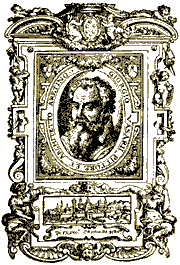Painter, architect and writer on art
Arezzo 1511- Florence1574
He studied the basic methods of the early Mannerist school of painting
in Rome and Florence, where he took his cue from Raphael and Michelangelo as
well as from Venetian influences. Thanks to his eclectic and scholarly education,
he was soon mixing in a favourable environment in Rome (1542-46) which brought
him into the circle of Cardinal Farnese, who gave him his first commission:
the series of paintings in the Vatican Chancellery. In the meantime he decided
to organize the notes he had made during his travels around Italy into a
literary form and the first edition of the "Vite dè più eccellenti
architetti, scultori e pittori" was published in Florence in 1550.
This book was to make him far more famous over the centuries than his work
as an artist.
His return to Florence was to bind him for the rest of his life to Duke Cosimo who
had a special project in mind which was the celebration of the Medici
family and the glorious past of Florence. Vasari became a key-figure in this
plan: he built the Uffizi (1560) and, with the
so-called Vasari corridor, carried out a spectacular
link between the centre of power (Palazzo Vecchio)
and the home of the Medici family (Pitti
Palace).

The conquest of Siena
the Hall of the Five Hundred -
Palazzo Vecchio
As planner and organizer he was at the head of what can be considered
an artistic "firm" that transformed Palazzo
Vecchio (the Hall of the Five Hundred, 1568, the little Study of Francesco
I, 1570-72).
Thanks to the encouragement of Cosimo I he was also able to found (1561) the
Academy of Drawing. In 1568 he published the second edition of "Vite",
brought up to date by the addition of contemporary artists: here we get the feeling
that he put little trust in the future and that he realised that the greatness
of Florentine art, which had reached its peak with Michelangelo, was a phenomenon
that was never to be repeated again.
The engravings used to portray the artists are taken from the
second edition of "Vite".

